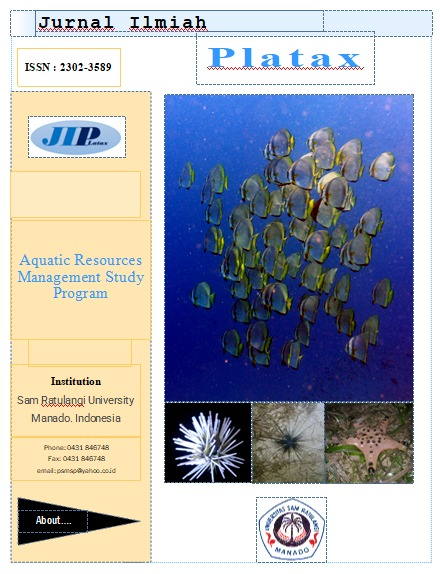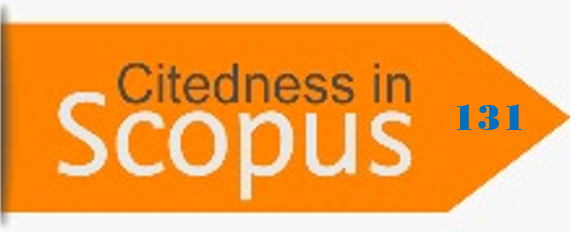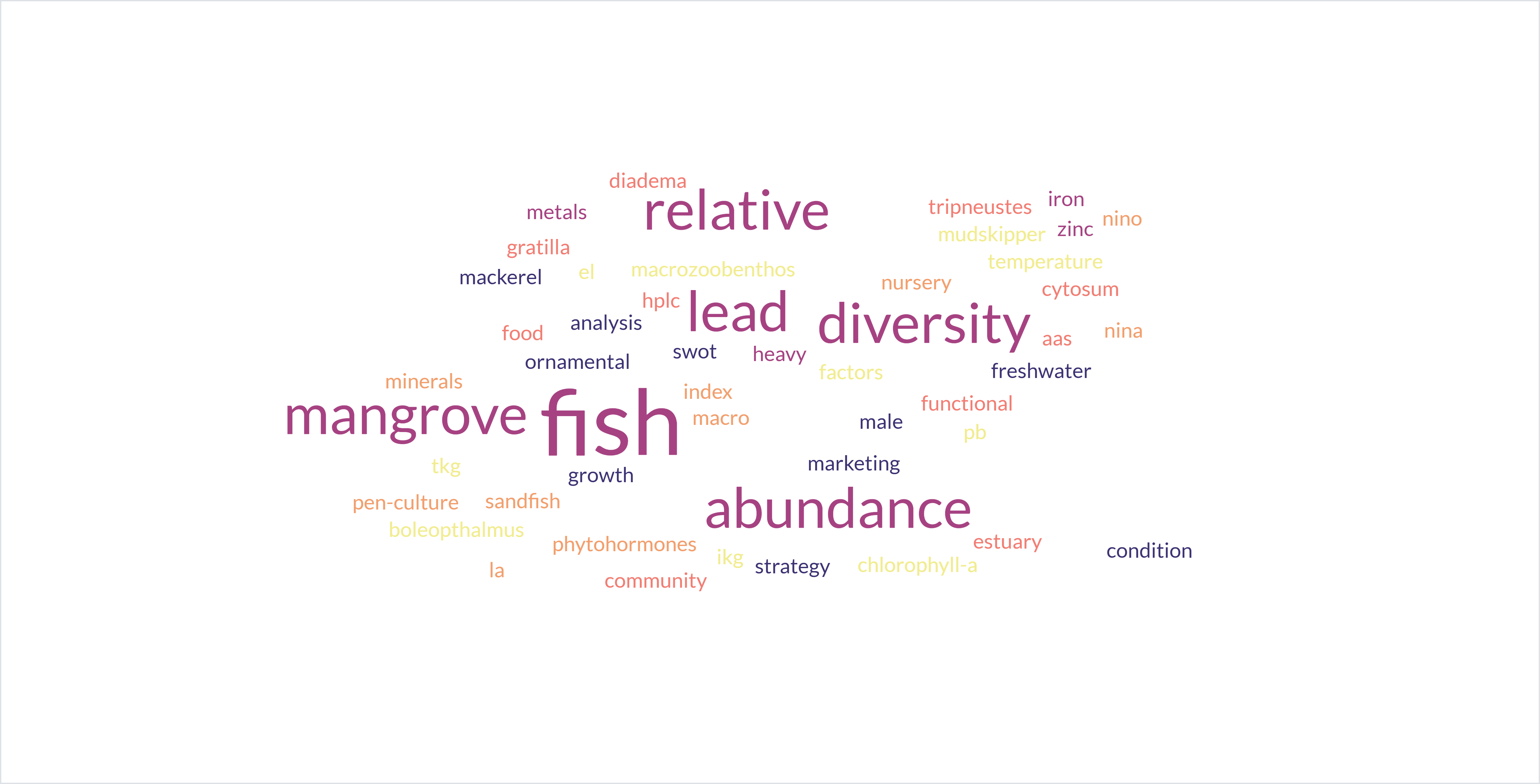Condition Factors and Length-Weight Relationships of Fifteen Important Fish Species in the Estuary of Manado Bay Indonesia
DOI:
https://doi.org/10.35800/jip.v11i2.51491Keywords:
species;, condition;, allomotric;, isomatric;Abstract
This research aims to analyze condition factors and growth patterns of estuary fish in Manado Bay. Sampling was carried out at the river estuary in Manado Bay, the Pineleng River in Bahu, the Sario River estuary in Sario, the Tondano River estuary in Sindulang, and the Bailang River estuary in Tumumpa. Sampling was carried out in June and July 2023 in the new moon and full moon phases at each river mouth. The fishing gear uses a beach seine 20 m long with a net height of 2 m. Analysis of condition factors and growth patterns using a length-weight relationship approach. Fulton's Condition Factor: K=100W/L3 Where K is the condition factor, W is the weight of the fish and L is the length of the fish (total length). Relative condition factor: Kn=W/Ŵ, where W is the weight of the fish and Ŵ is the estimated weight of the fish from the analysis of the length-weight relationship. Allometric and isometric growth patterns with length-weight relationship analysis: W=aLb where W is the weight of the fish (g), L is the length of the fish (cm), a and b are constants. During the research, 43 fish species were obtained and 15 of them were classified as important species whose presence was ≥1% relative abundance. Fulton's K obtained ranged from 0.69-1.76, the lowest species was 0.69 Stolephorus commersonnii and the highest was 1.76 Neovespicula depressifrons. The Kn value obtained for almost all species was ≈ 1.0, except for Sillago sihama, which was much smaller, namely 0.77. The value of the constant b relationship between length and weight varied between 2.22 in Caranx ignobilis and 3.9 in Ambassis gymnocephalus. The growth pattern is isometric for six species, negative allometric for four species, and positive allometric for five species.
Keywords: Species, condition, allomotric, isomatric.
Abstrak
Penelitian ini bertujuan untuk manganalisis factor kondisi dan pola pertumbuhan ikan muara sungai di Teluk Manado. Pengambilan sampel dilakukan pada muara sungai di teluk Manado, Sungai Pineleng di Bahu, muara Sungai Sario di Sario, muara Sungai Tondano di Sindulang dan muara Sungai Bailang di Tumumpa. Sampling dilakukan pada bulan Juni dan Juli fase bulan baru dan bulan purnama pada masing-masing muara sungai. Alat tangkap menggunakan pukat pantai panjang 20 m dengan tinggi jaring 2 m. Analisis faktor kondisi dan pola pertumbuhan dengan pendekatan hubungan panjang-berat. Fulton’s Condition Factor: K=100W/L3 Di mana K adalah fator kondisi, W berat ikan dan L panjang ikan (panjang total). Faktor kondisi relative: Kn=W/Ŵ, di mana W adalah berat ikan dan Ŵ adalah berat ikan yang diduga dari analisis hubungan panjang-berat. Pola pertumbuhan allometrik dan isometrik dengan analisis hubungan panjang-berat: W=aLb dimana W adalah berat ikan (g), L panjang ikan (cm), a dan b adalah konstanta. Selama penelitian diperoleh 43 speses ikan dan 15 diantaranya tergolong speses penting yang kehadirannya ≥1% kelimpahan relatif. Fulton’s K diperoleh berkisar antara 0,69-1,76 spesies terendah 0,69 Stolephorus commersonnii dan tertinggi 1,76 Neovespicula depressifrons. Kn diperoleh hampir seluruh spesies nilai ≈ 1,0 kecuali Sillago sihama jauh lebih kecil yakni 0,77. Nilai konstatnta b hubungan panjang berat berfariasi antara 2,22 pada Caranx ignobilis dan 3,9 pada Ambassis gymnocephalus. Pola pertumbuhan isometrik enam spesies, allometrik negatif empat spesies dan allometrik positif lima spesies.
Kata Kunci: Spesies, kondisi, almotrik, isomatrik.
References
Abobi, S.M. (2015). Weight-length models and relative condition factors of nine (9) freshwater fish species from the Yapei stretch of the White Volta, Ghana. Elixir Applied Zoology, 79: 30427-30431.
Barbier, E.B., Hacker, S.D., Kennedy, C., Koch, E.W., Stier, A.C. & Silliman, B.R. (2011) The value of estuarine and coastal ecosystem services. Ecological Monographs, 81, 169–193.
Carpenter, K.E. & Niem, V.H. (eds) (1999a) FAO species identification guide for fishery purposes. The living marine resources of the Western Central Pacific. Volume 4. Bony fishes part 2 (Mugilidae to Carangidae). Rome, FAO. 1999. pp. 2069-2790.
Carpenter, K.E. & Niem, V.H. (eds) (2001) FAO species identification guide for fishery purposes. The living marine resources of the Western Central Pacific. Volume 5. Bony fishes part 3 (Menidae to Pomacentridae). Rome, FAO. 2001. pp. 2791-3380.
Carpenter, K.E. & Niem, V.H. (eds) (2001a) FAO species identification guide for fishery purposes. The living marine resources of the Western Central Pacific. Volume 6. Bony fishes part 4 (Labridae to Latimeriidae), estuarine crocodiles, sea turtles, sea snakes and marine mammals. Rome, FAO. 2001. pp. 3381-4218.
Carpenter, K.E.; Niem, V.H. (eds) (1999) FAO species identification guide for fishery purposes. The living marine resources of the Western Central Pacific. Volume 3. Batoid fishes, chimaeras and bony fishes part 1 (Elopidae to Linophrynidae).Rome, FAO. 1999. pp. 1397-2068.
Chan, W., F. Talbot and P. Sukhavisidh, 1974. Carangidae. In W. Fischer and P.J.P. Whitehead (eds.) FAO species identification sheets for fishery purposes. Eastern Indian Ocean (Fishing Area 57) and Western Central Pacific (Fishing Area 71). Volume 1. FAO, Rome.
Costanza, R., d’Arge, R., de Groot, R., Farberk, S., Grasso, M., Hannon, B., Karin Limburg, Shahid Naeem, Robert V. O’Neill, Jose Paruelo, Robert G. Raskin, Paul Suttonkk & Marjan van den Bel. (1997) The value of the world’s ecosystem services and natural capital. Nature, 387, 253–260.
Elliott, M., A.K Whitfield, I.C Potter, S.J.M.Blaber, D.P.Cyrus, F.G.Nordlie, and T.D Harrison. 2007. The guild approach to categorizing estuarine fish assemblages: a global review. Journal Compilation Fish and Fisheries 8: 241–268.
Fischer, W. & P.J.P. Whitehead (Eds.) (1974), FAO species identification sheets for fishery purposes. Eastern Indian Ocean (fishing area 57) and Western Central Pacific (fishing area 71). Volume I-IV. Food And Agriculture Organization Of The United Nations.
Froese, R. (2006). Cube law, condition factor and weight–length relationships: history, meta-analysis and recommendations. J. Appl. Ichthyol. 22, 241–253.
Kottelat, M., A.J. Whitten, S.N. Kartikasari and S. Wirjoatmodjo, 1993. Freshwater fishes of Western Indonesia and Sulawesi. Periplus Editions, Hong Kong. 221 p
Le Cren E.D. 1951. The Length-Weight Relationship and Seasonal Cycle in Gonad Weight and Condition in the Perch (Perca fluviatilis). Journal of Animal Ecology, 20(2): 201-219.
Momi,M.M.A., M.S.Islam, S.Biswas. 2020. Condition factors: A Health indicator for cultivable fishes. Conference: 1ST Nstusc Science Fiesta 2020 At: Noakhali, Bangladesh. Affiliation: Noakhali Science & Technology University
Pauly D. (1984) Fish population dynamics in tropical waters: a manual for use with programmable calculators. ICLARM Studies and Reviews 8. Manila, Philippines. 325 pp
Petrakis G. and Stergiou K.I. (1995) Weight–length relationships for 33 fish species in Greek waters. Fisheries Research 21, 465–469
Richard D. M. Nash Antonio H. Valencia Audrey J. Geffen. 2006. The Origin o Fulton’s Condition Factor— Setting the Record Straight. Fisheries 31(5): 236-238.
Rodriguez, C., Galli, O., Olsson, D., Tellechea, J. & Norbis, W. (2017). Length-weight relationships and condition factor of eight fish species inhabiting the Rocha Lagoon, Uruguay. Brazilian Journal of Oceanography, 65(1): 83-86.
Stergiou K.I. and Moutopoulos D.K. (2001) A review of length-weight relationships of fishes from Greek marine waters. Naga, the ICLARM Quarterly 24, 23–39
Tesch, W. (1971). “Age and growth,” in Methods for Assessment of Fish Production in Fresh Waters, 2nd Edition, ed. W. E. Ricker (Oxford: Blackwell), 97–130.
Yosuva, M., Jeyapragash, D., Manigandan, V., Machendiranathan, M. & Saravanakumar, A. (2018). Length-weight relationship and relative condition factor of yellowfin tuna (Thunnus albacares) from Parangipettai coast, southeast coast of India. Zoology and Ecology, 28(2): 94-99
Zar,J.H. 1984. Biostatistical Analysis. Third Edition Prentice Hall, Inc Englewood Cliffs, New Jersey. 718 p
Downloads
Published
How to Cite
License
Copyright (c) 2023 Gaspar Manu, Nego E. Bataragoa, Stephanus V. Mandagi, Dulce Maria Dauhan, Ayumi Angraini Sampe

This work is licensed under a Creative Commons Attribution-NonCommercial 4.0 International License.
COPYRIGHT
Authors who publish with this journal agree to the following terms:
Authors hold their copyright and grant this journal the privilege of first publication, with the work simultaneously licensed under a Creative Commons Attribution License that permits others to impart the work with an acknowledgment of the work's origin and initial publication by this journal.
Authors can enter into separate or additional contractual arrangements for the non-exclusive distribution of the journal's published version of the work (for example, post it to an institutional repository or publish it in a book), with an acknowledgment of its underlying publication in this journal.
Authors are permitted and encouraged to post their work online (for example, in institutional repositories or on their website) as it can lead to productive exchanges, as well as earlier and greater citation of the published work (See The Effect of Open Access).




















